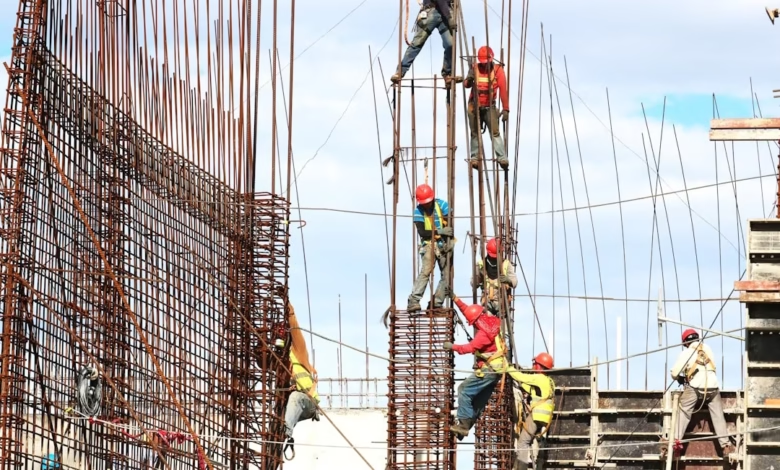Exploring Construction Metals: A Comprehensive Guide to Steel, Aluminum, and Beyond in Sustainable Building Materials

In the ever-evolving landscape of construction, the choice of materials plays a critical role in determining the durability, sustainability, and overall success of a project. Among the most significant options available are construction metals, which include a diverse array of both ferrous and non-ferrous metals. Steel and aluminum are two of the most widely used construction metals, but the industry also benefits from a variety of other industrial metals like copper and zinc, each bringing unique properties to the table. As we delve into the intricacies of metals in building materials, we will explore the differences between ferrous and non-ferrous options, highlighting their applications in construction and their importance in metal mining and metallurgy.
Moreover, the growing emphasis on sustainability has led to innovative trends in metal recycling, showcasing how the construction industry can utilize recycled materials to reduce waste and minimize environmental impact. The rise of metal alloys has also transformed the way we approach construction, offering enhanced performance characteristics for various applications, from aerospace and automotive industries to energy-efficient buildings. Join us as we navigate through these essential aspects of construction metals, their role in sustainable practices, and the future of metallurgy in the building sector.
- 1. Understanding Construction Metals: A Deep Dive into Ferrous and Non-Ferrous Options
- 2. The Role of Metal Recycling in Sustainable Construction: Innovations and Trends
- 3. Exploring Metal Alloys and Their Applications in Building Materials: From Steel to Aluminum and Beyond
1. Understanding Construction Metals: A Deep Dive into Ferrous and Non-Ferrous Options
When exploring construction metals, it's essential to understand the two primary categories: ferrous and non-ferrous metals. Each plays a vital role in the building materials industry, impacting everything from structural integrity to sustainability.
Ferrous metals, primarily composed of iron, are known for their strength and durability. Steel, a prominent example, is widely used in construction due to its remarkable tensile strength and versatility. It forms the backbone of many structures, from skyscrapers to bridges. However, ferrous metals are prone to metal corrosion, which can compromise their integrity over time. To combat this, various protective coatings and treatments are employed to enhance durability and extend the lifespan of steel structures.
On the other hand, non-ferrous metals, which do not contain significant amounts of iron, include aluminum, copper, zinc, and precious metals like gold and platinum. Aluminum is particularly favored in construction for its lightweight properties and resistance to corrosion, making it ideal for applications ranging from roofing to window frames. Copper is another critical non-ferrous metal known for its excellent conductivity and is often used in electrical systems within buildings.
The growing emphasis on sustainable metal production has led to advancements in metallurgy and metal recycling practices. By recycling metals, such as aluminum and copper, the construction industry can significantly reduce its carbon footprint while conserving precious resources. Additionally, the rise of metal alloys—combinations of metals that enhance certain properties—offers innovative solutions for construction challenges, providing materials that are stronger, lighter, and more resistant to environmental factors.
Emerging metal trends, including the use of energy metals like lithium in battery technologies, are also influencing the construction sector. As industries evolve, integrating materials that support renewable energy solutions becomes increasingly relevant. Moreover, the advent of 3D printing metals is revolutionizing construction, allowing for customized designs and efficient material use.
Incorporating a diverse range of metals, including rare earth metals and refractory metals, into construction practices not only enhances structural performance but also aligns with the industry's move towards more sustainable and efficient building methods. Ultimately, understanding the differences between ferrous and non-ferrous metals and their respective applications is crucial for anyone involved in construction, whether in material selection or innovative design.
2. The Role of Metal Recycling in Sustainable Construction: Innovations and Trends
The construction industry is increasingly recognizing the importance of metal recycling as a vital component of sustainable building practices. As the demand for construction metals like steel, aluminum, copper, and zinc continues to rise, so does the need for responsible sourcing and utilization of these materials. Metal recycling not only helps conserve natural resources but also significantly reduces the environmental impact associated with metal mining and production.
Innovations in metal recycling technologies are transforming the way construction metals are sourced and utilized. Advanced metallurgy techniques are being developed that enhance the efficiency of recycling processes. For instance, the use of automated sorting technologies can separate ferrous and non-ferrous metals, ensuring that only the highest quality materials are reintroduced into the production cycle. This is particularly important for precious metals such as platinum and palladium, which are often found in smaller quantities but are crucial for various applications, including electronics and automotive industries.
Recent trends in metal recycling also highlight the increasing integration of 3D printing metals in construction. This innovative approach allows for the creation of complex metal components with minimal waste, as materials can be precisely shaped and reused in new forms. Additionally, the rise of battery metals, particularly lithium and other energy metals, underscores the necessity of recycling within sectors striving for sustainability. These metals are essential for technological advancement and energy storage solutions, making their recovery and reuse critical.
As the construction sector shifts toward more sustainable practices, the use of metal alloys and the recycling of base metals will play a significant role in minimizing metal corrosion and extending the lifespan of construction materials. The focus on sustainable metal production not only addresses environmental concerns but also opens new avenues for investment. Gold investing and silver investing are becoming increasingly attractive as the market for recycled metals grows, supporting the development of a circular economy.
In summary, the role of metal recycling in sustainable construction is pivotal, driven by innovations and trends that aim to optimize the use of industrial metals. By embracing these practices, the construction industry can significantly contribute to environmental sustainability while also ensuring the availability of high-quality construction metals for future projects.
3. Exploring Metal Alloys and Their Applications in Building Materials: From Steel to Aluminum and Beyond
In the realm of construction, the choice of materials significantly impacts the durability, sustainability, and overall performance of buildings. Among various options, metal alloys stand out due to their diverse properties and applications. Understanding these alloys is essential for optimizing building materials, as they encompass both ferrous and non-ferrous metals that contribute uniquely to construction projects.
Steel, one of the most prevalent ferrous metals, is renowned for its strength and versatility. It is commonly used in structural applications due to its high tensile strength and resistance to metal corrosion. Steel alloys, which may include elements like chromium and nickel, enhance these properties further, making them ideal for use in frameworks, roofing, and reinforcements. The process of metallurgy, which involves the manipulation of metal to improve its characteristics, plays a critical role in developing these alloys.
On the other hand, aluminum, a prominent non-ferrous metal, offers lightweight and corrosion-resistant properties, making it a preferred choice for various applications in construction. Aluminum alloys, often combined with elements such as copper or zinc, exhibit increased strength and formability, making them suitable for window frames, roofing sheets, and even decorative elements. The rise of sustainable metal production has led to increased interest in aluminum recycling, which not only preserves resources but also reduces environmental impact.
In addition to steel and aluminum, other industrial metals like copper and zinc also play vital roles in construction. Copper, known for its excellent electrical conductivity, is often used in wiring and plumbing, while zinc is used for galvanizing steel to prevent corrosion. Emerging trends in construction, such as 3D printing metals, are also influencing the choice of materials. These technologies allow for the fabrication of complex structures using metal alloys, providing architects and builders with greater design flexibility.
Moreover, the growing interest in battery metals like lithium and precious metals such as gold and silver reflects a broader trend towards integrating cutting-edge technologies into construction practices. Gold investing and silver investing, while primarily associated with the financial sector, also highlight the importance of these metals in various applications, including energy storage solutions and high-end finishes in construction.
As the construction industry evolves, the exploration of metal alloys continues to reveal new possibilities. Innovations in metal mining and metallurgy are driving the development of advanced materials that meet both performance standards and sustainability goals. From aerospace metals designed for lightweight strength to automotive metals that offer enhanced safety, the potential applications of metal alloys in building materials are vast and varied. Sustainable practices, including metal recycling and responsible sourcing, will ensure that the future of construction remains environmentally conscious while leveraging the unique properties of these vital materials.
In conclusion, the exploration of construction metals—spanning from ferrous to non-ferrous options—highlights their pivotal role in modern building practices. Understanding the differences between industrial metals, such as steel and aluminum, and their unique applications helps stakeholders make informed choices that enhance both structural integrity and sustainability. As we advance towards sustainable metal production, the significance of metal recycling becomes increasingly apparent, allowing us to minimize waste and embrace innovative practices within the construction industry.
Moreover, the various metal alloys discussed offer a glimpse into the future of construction materials, where advancements in metallurgy and metal fabrication are shaping the landscape. From aerospace metals to automotive metals, the versatility of base metals like copper and zinc, alongside precious metals like gold and silver, underscores their importance not only in construction but also in broader sectors such as jewelry and energy.
As the world leans more towards sustainable practices, the trends in metal mining and the focus on battery metals, rare earth metals, and refractory metals will play a crucial role in driving the industry forward. The integration of 3D printing metals in construction signifies a revolutionary shift that aligns with modern demands for efficiency and customization.
Ultimately, by staying informed about metal trends and investing wisely—whether in gold investing or silver investing—construction professionals can better navigate the evolving landscape of construction metals. Embracing these developments will not only enhance project outcomes but also contribute to a more sustainable and resource-efficient future in construction.





